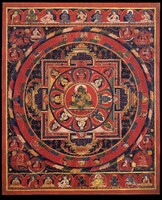A Really Fascinating Milarepa Painting

The Winter Palace Museum has some interesting objects and with paintings there are a couple that stand out and really command attention. One of those paintings is a life story composition of Milarepa. The entire life story is contained in the single composition. Everything about it is unusual from the artistic style to the selection of narratives depicted surrounding the central figure.















